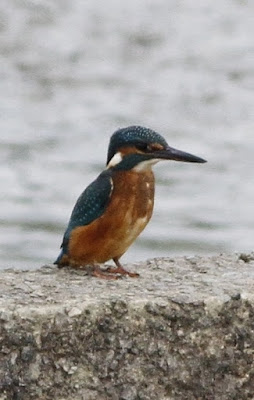started to break up and the first of 5/6 Brown Hairstreaks was seen , all females , and all intent to lay
their eggs , this being the first decent day to do so for ages . Because they were so intent on doing so ,
they rarely stayed still .clambering amongst the youngest shoots of the Bullace plants to do so .
Having layed that one , the small white spot just above the end of her abdomen , it was off to find the next suitable place . When things went quiet , we had a look around another recently cleared area , but here too , butterflies were very few . Only other interest found was a male Brown Hawker ,
warming up in the sunshine just after we arrived . Before heading home , we had a look around Cissbury Ring , but apart from fantastic views all around and a strong wind blowing over the site , butterflies here too were in short supply , but Martin did spot this large fungi , between bread anddinner plate in size across , Lepiota procera / Parasol Mushroom .
A couple of days later after a wet morning , I managed a bit under an hour looking up on the Greensand Ridge for any signs of reptile breeding , but I only managed to find two males , one
stretched out to make the most of the warmth , the other two weren't so trusting on the weather ,
staying tucked up together .
With the start of the new hedgelaying season , we spent a very wet few hours last Saturday coppicing materials for the first hedge next Saturday . On the way back , a brief spell of broken cloud allowed a look around the Common . Needless to say , everything was very wet , but I did record four species
of butterfly , including a couple of Small Heath , a species that has been very scarce on site this year .
Yesterday morning I managed to do the High Elms Butterfly transect , having not been able to get out and do it last week . The recent rain and colder temperatures had obviously taken their toll as numbers were again well down , but I did record 11 species , which included the first Small Copper
of the year on site , most unusual , and a single male and female Silver-washed Fritillary on the wing . Six Hornets were also seen , four of them seemingly working together as a pack . On the way
around the Conservation field , almost every fence post had a Robber Fly / Asilidae sp. , either warming up or looking for it's breakfast , and on Burnt Gorse looking almost
dead , but in full flower , Carline Thistle / Carlina vulgaris . This is as flowery as it gets . In the afternoon , whilst helping Carol with the garden , I found a Cricket that usually spends it's time in the canopy of large trees . This one , the Southern Oak Bush-cricket / Meconema meridionale , probably
got dis-lodged during the heavy rain and winds recently .
Wasn't sure where to go this morning , but finished up at Bough Beech Reservoir , and on arrival got
a Sparrowhawk circling the causeway before flying off , result . A look over the hedge at the North
Lake produced a small flock of Teal , two juvenile Shellduck and over by the island , a Greenshank .
Another scan around found it's cousin , a Spotted Redshank , and it got even better when the
Greenshank flew over and joined it's cousin . Meanwhile , over Winkworth Woods , what looked like
a family group of four Common Buzzard appeared above the tree line for a short while , before
disappearing below again . One of the group did re-appear over the North Lake , putting everything up . If that wasn't enough , we were then treated to a Red Kite which flew high over the North Lake ,
before thermaling up into the sun above the causeway . One , probably two Kingfisher , darted backwards and forewards across the North Lake , one eventually settling for a few seconds on the
culvert wall . Two having appeared briefly earlier , we were then treated to a small herd of 9 Fallow
Deer that stayed for a minute or two , grazing on the far bank of the North Lake , just left of the island . Apart from the Snipe on the North Lake and a fly by just before I left , from a male Kestrel ,
it was quite a quiet visit .
























4 comments:
Okay! What an amazing outing. I love the birds. I'm not sure why a Greenshank is called a greenshank. I get the Spotted Redshank.....but green would make it sound as if there were green on the bird. Maybe in breeding plumage??
Chris ,
As you say the Greenshank's plumage is basically grey and white .
The 'shank' part of it's name refers to it's legs , which are a dirty green colour . On the same lines , the Spotted Redshank and the Redshank both have orangey/red legs . This is obviously more noticeable when the waders are out of the water . The other identifying feature of the Greenshank is a slightly upturned bill .
Some top stuff in this post Greenie.
Love the Robber fly and the Brown Hairstreaks, both of which I haven't seen for a long time.
Great pics!
Greenie.
Good day for seeing birds of prey, especially seeing my favourite bird, the Red Kite, plus2 waders that I am still chasing, I think I had better go to Bough Beech asap.Nice pictures.
Post a Comment